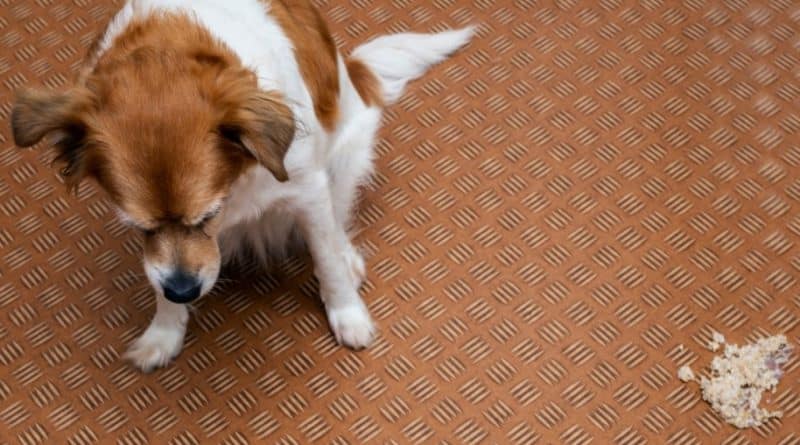What to do when the dog vomits
A dog vomiting is more common than we imagine, but it should not be treated as unimportant. This is because a dog that has vomited may be feeling anything from mild discomfort due to eating too fast to having a more serious illness whose initial symptom is vomiting.
If you found this article after searching for “my dog won’t eat and is vomiting and sad,” stay with us until the end of the reading to learn about some possible causes for this condition.
In any case, schedule a consultation with the veterinarian as soon as possible because only a healthcare professional can make a correct and precise diagnosis of your dog, indicating the most appropriate treatment for them.
Dog vomiting: what could be happening?
Whenever a dog vomits, the owner is likely to be alarmed, and the first thoughts are likely to be the worst. We immediately fear that it is a serious illness, and our furry friend is suffering. But wait! The most important thing at this moment is to act with attention and promptness, taking the pet to the veterinarian as soon as possible.
Also, it’s important to recognize the difference between a dog vomiting and regurgitating. When a dog regurgitates, the expulsion comes from the esophagus and can occur when they eat too fast or do not have proper digestion, for example.
When a dog eats something that does not agree with them, it is common for them to vomit, expelling something from the stomach. There are very characteristic types of vomiting that can indicate different health problems. Learn more about them below so you can report to the vet what happened in the best way.
My dog is vomiting: what are the causes?
There are many explanations for a dog vomiting, and only the veterinarian can accurately say what is happening with your pet. Nevertheless, it is worth knowing the main causes of vomiting in dogs. See below.
- Dog vomiting yellow
The yellow vomit from the dog often represents a way for the body to defend itself from something that is not good for it. It could be:
- an alteration in liver function;
- excessive anxiety, very common in dogs not used to being alone;
- a consequence of acute pain or other diseases;
- due to prolonged fasting, where the stomach remains empty for too long.
In general, a dog vomiting yellow foam is expelling bile, a substance manufactured by the liver and released by the gallbladder of the pet. It is common for a dog with an empty stomach to vomit yellow due to the irritation that bile causes.
- Dog vomiting green
Like yellow vomiting, a dog vomiting green may have a completely empty stomach. The difference in this case is the larger amount of bile irritating the stomach lining, which usually occurs when the pet vomits several times.
Green vomiting can also be indicative of more serious diseases and should not be neglected. If accompanied by diarrhea or other symptoms, it may be a sign of something serious.
- Dog vomiting white foam
It can sometimes be challenging to notice that a dog has vomited white foam because the appearance can be very similar to saliva. The presence of foam in the dog’s vomit may indicate:
- food poisoning;
- gastritis and other inflammations or infections in the stomach and intestines;
- other serious diseases;
- reflux, indigestion, and nausea, common when the dog eats too quickly and does not chew properly.
It is essential to report to the veterinarian if episodes of a dog vomiting were isolated or if they occurred frequently (and what the frequency was), as well as the presence of other symptoms such as fever, lack of appetite, pain, and cough.
- Dog vomiting blood
This is undoubtedly one of the most frightening situations for the owner. A dog vomiting blood usually triggers our red alert, and for a good reason. The first step in this case is to check if the blood is coming from any injury in the dog’s mouth, such as a broken tooth or a wound on the tongue. Be very careful in this investigation so that the dog does not bite, as they may react this way if they are in pain. Another important point is to observe the color of the blood: usually, a brighter red indicates injuries in the mouth, while dark red can mean gastrointestinal problems.
Attention: if blood is also present in the feces, do not wait! Acting quickly can save your best friend’s life, as bleeding can be due to internal injuries and other serious causes such as:
- worm infestations;
- coagulation disorders;
- tick-borne disease;
- parvovirus;
- canine distemper;
- cancer;
- various infections;
- ingestion of sharp and foreign objects.
What is good for a dog when they are vomiting? The most valuable tip for this condition is to have frequent check-ups. These are preventive actions aimed at identifying infections or other diseases related to a dog vomiting blood.
- Dog vomiting brown
Brown vomit in dogs is not always a sign of poorly digested food, but this is the main cause. If the dog vomited the entire meal, it may be a good idea to invest in slow feeders, which help the pet eat more slowly and chew the food better.
Another quite common possibility is coprophagy, that is, the habit that some dogs have of ingesting their own feces. Although this practice is more common in some breeds than in others, it is generally associated with behavioral disorders such as anxiety and the need to attract the attention of the tutors.
There are several ways to solve the problem, including with the support of medications, but the main means of correction usually involve the participation of a dog trainer.
- Dog with vomiting and diarrhea
If a dog is vomiting and has diarrhea, they may have food intolerance. It could be a momentary discomfort, such as overdoing it with a new treat, for example, or a sign of something more serious.
Many serious diseases, such as giardiasis, canine distemper, parvovirus, and other parasitic diseases, present vomiting and diarrhea as some of the main symptoms. Keep your pet’s vaccines up to date, as well as protection against fleas and ticks, and talk to the vet.
What to do when a dog vomits?
Seeing a dog vomit can be distressing, especially for first-time owners. However, there are some tips that can help you deal with this problem.
Before anything else, it is essential to observe if the animal is experiencing any other symptoms besides vomiting, such as fever or diarrhea. Also, pay attention to how often the vomiting occurs.
If the frequency is high and the animal has other symptoms, they may have some other pathology, so do not wait and rush to the vet. However, if the animal vomits only once and stops, it will be necessary to analyze the type of vomit.
Take the dog to the vet
Still talking about what to do when your dog vomits, we recommend paying attention to the dog’s behavior after they vomit foam or blood. Observe well to try to find out what may have caused this scare. If vomiting continues or if the pet does not want to eat or drink water, take them to the veterinarian without delay.
Do not offer homemade remedies for a dog vomiting, as even with good intentions, you can worsen the pet’s health condition. After a thorough assessment, the veterinarian may recommend a suitable dog vomiting medicine, including dosage recommendations and treatment duration.
Another tip is to pay attention to the type of feces the animal is producing. Observe if they are evacuating
normally or if they show signs of constipation or diarrhea. Any extra information can be crucial when talking to the vet.
So now you know what to do when a dog vomits, so share and help other people take better care of their pets.




